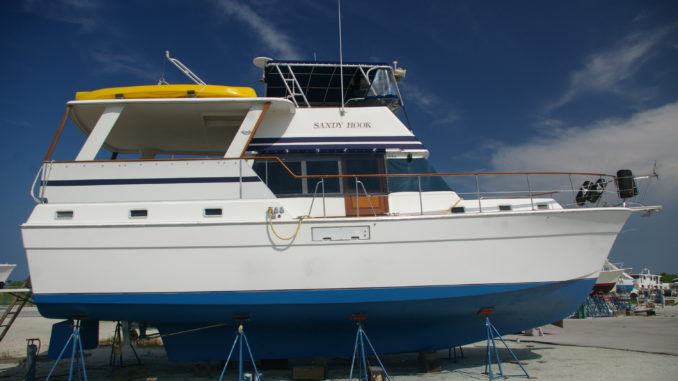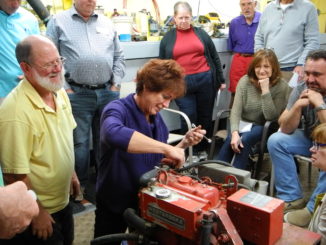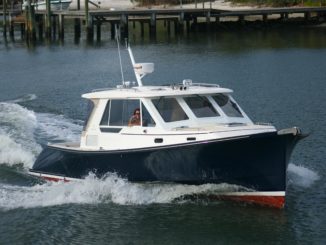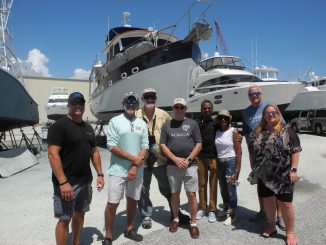
Boatyard Lingo
Cruisers have a language all our own. If you are new to this adventure then you may not yet understand what our gibberish means. This new language is particularly important to decipher when you enter the world of the boatyard. When is a boat shoe not something you wear on your feet? A skeg, a shoe, and a V- strut all have something in common. But what are they and what do they do? Every old skipper may toss around these strange salty terms so let’s help you interpret what they mean and how you can learn to speak Boatyard Lingo too.
The Boatyard is a wonderous place on dry land with boats of all sizes in various states of repair. But a boatyard is also a place of business and usually has work in progress. So, proceed at your own risk, follow the safety signage and be respectful of private property. You will see boats up on the hard, supported by tripods, blocks and straps. But how did they get up there and what keeps them from toppling over.
Enjoy this list of terms found in a boatyard when it’s time for a haulout. Don’t forget to scroll to the end and click on the video of a few other boat systems equipment and terms that are important to a new boat owner.
Travel lift –
This heavy-duty machinery will haul boats of various sizes from the water up onto dry land- also called “on the hard.” The travel lift straddles the boat slip which is called a haul out well. Then the lift operator slides straps under the hull of the boat from starboard to port sides and these straps are attached to the travel lift itself. Depending on the length and weight of the boat, two or more straps will cradle the boat’s beam as the travel lift raises the boat from the water.
Tripods & Blocks –
The boat is lowered down by the travel lift onto wooden blocks. The keel is balanced on these blocks, fore and aft. The hull is supported by pairs of tripods, one on each side from bow to stern. In hurricane season you may see these tripod pairs chained together from one side of the boat to the other. This will prevent the tripods from wiggling out of position. It helps that you remove sails and canvas from catching more wind and challenging the balance of the boat.
Bottom Job –
You can stop blushing. This bottom refers to the underside of the boat’s hull. And the job in question usually includes a haul out, pressure washing and eventually a few coats of paint. The pressure washing removes surface growth and dirt, allowing us to see the condition of the hull. If all is well, sand the hull down then apply antifouling paint to prevent immediate attachment of marine growth once the boat is back in the water.
Blisters –
During the pressure washing and sanding process you should look at the condition of the hull surface. It should be smooth and without blemish. If you see any raised areas or the appearance of bubbles beneath the antifouling paint ask the boatyard staff for closer inspection. This could mean your boat has osmotic blisters. Unlike blistered skin from the sun, the osmotic blister occurs when water seeps through the gelcoat layer into the structural fiberglass layup of the boat hull. Blisters should be taken care of. It could be a simple as grinding through a layer or two, allowing it to dry and then refilling with an epoxy resin. In some cases, the entire hull needs to be peeled of the gelcoat layer all the way down to the dry fiberglass layers. This is often more than a simple DIY project.
Paint –
After any fiberglass repair such as blisters or an entire hull peel, the affected area should be painted with a barrier coat. This prevents water from permeating into the fiberglass layer of the hull and is applied before the antifouling paint. Antifouling paint choices include Ablative which is a soft coating and Hard paint which is not really hard like the paint on the fender of your car but harder than Ablative. Both have toxins which are designed to prevent marine growth from attaching to the hull. Nothing works forever so plan on hauling out again every 12-24 months. Depending upon how often you use the boat or leave it sit in the water of your marina, growth happens. Having a diver scratch the bottom every month or two can extend time between haul outs but tell him not to be too aggressive and scratch away all the antifouling paint.
Running gear –
Nope, not topsiders or anything else you wear on your feet. Propellers, shafts, rudders and trim tabs if equipped are considered your running gear. When you notice any vibration or unusual noise while underway you may want to have your propeller checked to see if it is true and exact with proper pitch and angle. The shaft should be straight, rudders snug with no play and inspect the trim tabs for any hydraulic fluid leak. These are all made from different metals and must be protected by sacrificial anodes. Depending on the water that your boat is used in – salt, brackish or fresh- the anode may be made of zinc, magnesium or aluminum. Check with your boatyard for the proper metal anode.
Running gear support –
The skeg is an extended keel which will protect the propeller and rudder. The shoe is commonly found on a wooden boat and is a softer wood than the hull. It will act as a sacrificial material that worms and other marine wood borers will attack instead of attacking the wood comprising the boat hull. A shaft strut supports the propeller shaft. You may find a V-strut supporting the shaft of a boat with a more powerful larger propeller. On other boats it takes the shape of an I instead of a V so it is called an I-strut or just a strut. All struts have a vulcanized rubber insert that is called a cutlass bearing. The cutlass bearing is what prevents a metal shaft to metal strut contact.
ICW Mustache –
Some of you take the opportunity to grow a nice set of whiskers while cruising. But this mustache is found on the bow of your boat at the water level in the ICW (IntraCoastal Waterway). A brown stain starts to form as your bow wake splashes against your hull. Tidal waters often have tannin from the tree roots and leaves that also make the water a darker brown tea color. This tea stain finds its way into the porous fiberglass gelcoat that is unprotected by wax. Good news! You don’t have to haul your boat to clean this badge of honor from your bow and sometimes swim platform. Straight lemon juice in a spray bottle will make this brown stain magically disappear in minutes. No scrubbing. The next time you are in the boatyard reapply your wax to prevent further staining.
No cash, no splash –
This phrase is heard when the work is done and you are ready for your boat to be put back in the water. The Boatyard wants to be paid when you leave their property so make arrangements before launching. Some yards are still small enough that credit cards are not an option. Hard to believe but it’s true.
Learn More
So now you know some Boatyard Lingo to begin a conversation with a marine professional. Here are a few more terms and pieces of equipment you want to become more familiar with in our YouTube Video Learn the Lingo. These fun phrases will start you on your way but there is always more to learn. Join us for a Boatyard Tour or a 2 day seminar in Vero Beach FL to be better prepared for your boating adventure. When you read or hear other marine phrases that need a translation…Ask Captain Chris.
Article originally found in WaterwayGuide annual magazine. Captains Chris & Alyse Caldwell are USCG 100-ton Masters and Cruising Coaches who offer Personal Boat Training Online or Onboard your boat anywhere! The Caldwell’s help build your cruising confidence with hands-on training, with their AskCaptainChris.com training videos and through 2-day seminars filled with tons of tips for the boater who loves learning. If you have additional questions for Captains Chris or Alyse, please call 772-205-1859 or email them at chris@captainchrisyachtservices.com



